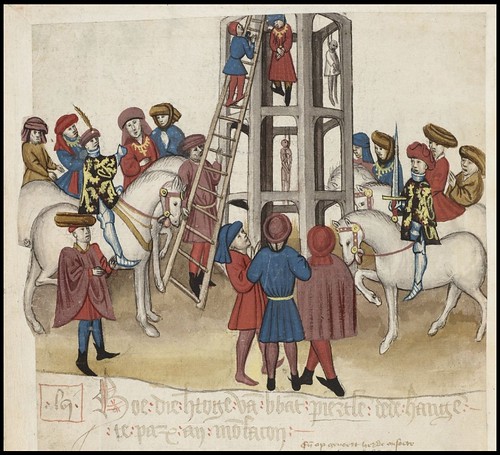Brabantsche Yeesten
by
Jan Van Boendale (c.1280-1351)
by
Jan Van Boendale (c.1280-1351)
"His first work, the Brabantsche yeesten (Brabantine Deeds), is a chronicle in coupled rhyme, dealing with the history of the Brabantine ducal house in the period from ca. 600 to ca. 1350. This chronicle is divided in five parts (“books”), of which the first four describe the history of Brabant before Boendale’s own lifetime, and the fifth is devoted to the three dukes contemporaneous with him: Jan I (d. 1294), Jan II (d. 1312), and Jan III (d. 1355). This voluminous work of some 16,000 lines was not written in one effort; the first version dates from ca. 1316, the fifth from 1347, and a sixth version may have been written around 1351, each one providing an updated version of the history of the duchy." [source]















[all images above were spliced together from screencaps]
From rather opaque translations (the usual for Dutch-to-English), it appears that Jan Van Boendale's 14th century 'Brabant Chronicle' manuscript was "discovered" in the 19th century in a tobacconist shop where it was to be torn up and used as wrapping paper.
There is little mention of the illustrations or why they were excised and re-mounted in a secondary volume. Supposedly two volumes have been digitised and uploaded and it may be that the both are contained in the one "book". The array of images above is a fair sampling of the sorts of events recorded through the available manuscript of medieval life in the Brabant region of Belgium. They are essentially universal themes - of love, marriage, war, clergy, noblemen and soldiers - one might expect to be depicted in any medieval town's chronicle, so it's hard to guess when the events took place.
The scene showing the killing of the Duchess above *might* be Marie of Brabant, who was beheaded by her husband for adultery (the customary punishment of the time). That took place in the middle of the 13th century. But any apparent visual narrative in the selection of images above is coincidental: they are doubtless showing scenes from varying periods and are almost certainly out of order.
- 'The Chronicle of Brabant' (Brabantsche Yeesten) is owned and hosted by the Royal Library of Belgium --> "Feuilleter le document (ms. IV 684)" : click to open a fairly friendly flash viewing window.
- Jan van Boendale biography said to be from 'Medieval Germany: An Encyclopedia'. [W]
Hello :)
ReplyDeleteBig fan of your blog here. Thank you so much for your amazing work!
I'm currently looking for a good / very good digital edition of 'Emblemata Saecularia' of Jean-Théodore & Jean-Israël de Bry. Can you help me with this? Thank you very much.
P.S. Please check also my tumblr:
ReplyDeletehttp://speciesbarocus.tumblr.com/
Doubtless your google is as good as mine but ;-) although I don't recall that particular emblem book, it seems that this is probably the best stash, followed by the British Museum (search on "saecularia") - not sure if either of these are complete. I think there's only 2 major emblem university centres: Scotland, Holland (?Leiden) and somewhere in the NE of USA. They're easy to find: I'd write to one of them and ask.
ReplyDeleteThank you so much for your help!
ReplyDelete